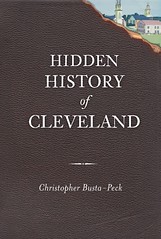As you may know, I'm a children's librarian. I've looked and looked, and there simply aren't any good childrens books dealing with Cleveland area.
A colleague suggested I look at The Day-Glo Brothers: The True Story of Bob and Joe Switzer's Bright Ideas and Brand-New Colors, written by Chris Barton and illustrated by Tony Persiani. She thought it was interesting just as a quality work of non-fiction. I knew that there was some sort of local connection, and I wanted to see what it was.

The book tells the story of two brothers, growing up in Montana, and their ambitions. The story begins in black and white, and progresses to a wild spectrum of Day-Glo greens, yellows, and oranges. Barton tells the story of how the brothers moved to Cleveland, to be closer to their markets, which at the time were limited by the fact that their inks only glowed under artificial light. Here, in 1938, they discovered how to make paints that glowed in daylight. We learn about their pursuits, initially medicine and magic, and how, together, they created the company that became known as Day-Glo. Finally, we learn about how these colors work and the many ways that they are used.
Chris Barton does an excellent job of telling the story. Tony Persiani's illustrations are stellar, fully utilizing Day-Glo colors to illustrate the story in an utterly compelling manner. This approach to illustrating science and invention definitely raises the bar.
Initially, I was displeased with the lack of "Cleveland" in the book. The first 20 pages provide background, dealing with Joseph and Robert Switzer's childhood and lives as young adults. Once they move to Cleveland, the story is more about their inventive process and the various uses of these new paints than it is about their lives in and impact on Cleveland.
Then I remembered that this was a book for children, not an academic paper. I was wrong. The backstory and numerous illustrative examples are absolutely crucial for the manner in which the story is told. It's called character development.
The last two pages of the book, the author's note, provided the biggest surprise for me. On them, Chris Barton describes his research process. I read this eagerly, curious as to what sources he'd been able to locate that had eluded me. I was shocked to find that the book was almost entirely original research.
Barton talked to Joseph and Robert Switzer's family members and colleagues. He consulted their original letters and notes. He put the story together.
This is unusual at best. Non-fiction for children tends to be the same stories, rehashed again and again, relying exclusively on secondary materials. Among those that are well done, it can be difficult to find ones that are visually compelling.
This should be taken as a lesson as to what children's non-fiction should be. I recommend it highly both as a librarian and local historian.




great!
ReplyDelete